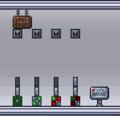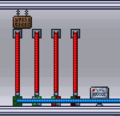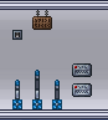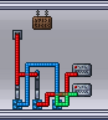User:Andrio Celos
Wiring Experiments
First, I will mention that I don't like calling faulty logic gate lamps that. I prefer 'randomiser lamp', especially because they cost a lot more than normal logic gate lamps. Any logic gate with a randomiser lamp on it becomes a randomiser gate.
1: Wire order
There's no picture of this test here, because it's a mess. The test determines the order in which mechanisms are activated. Machanics follow a breadth-first search, with priority down > up > east > west.
2: Single-input randomiser gate
The announcement is triggered as the lamp turns on. Reversing the order of activation doesn't change the result here.
3: Toggling multiple inputs
Here, the announcement is never triggered. The logic gates are checked only after all the lamps have finished toggling.
4: Coin flip mechanism
The gates are checked in order from left to right (the purpose of gate A is to ensure that). Gate A turns on gate C, then gate B flips the 'coin'. If heads, gate B turns off gate C and that's it. If tails, gate C remains on, then turns itself off when it triggers. This all happens within a single frame.
5: Interacting gates
What's happening here? First, gate A is toggled. Then gates A and B are checked in order. The gates only actually trigger after all checks are done. This means that if gate B is going to trigger, gate A can't stop it.
The coin flip mechanism works because it's gate A that triggers the check of gate C. This only happens after gates A and B are checked, and after they trigger.
6: Feedback loop
Recall that logic gates trigger whenever they change state. A two-input XOR gate triggers when either input is toggled. This triggers gate B, which in turn would trigger gate A. But the game realises that gate A has already triggered, and creates a smoke machine rather than an infinite loop.









